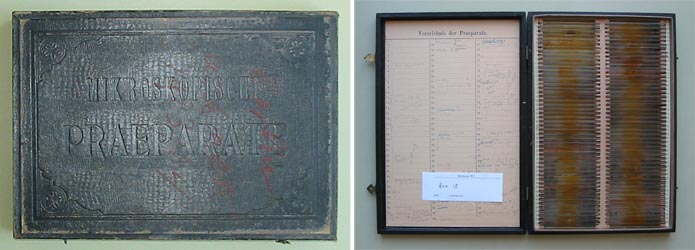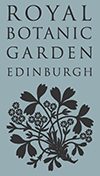Slides
The slides are currently contained in over 20 boxes, most of which are like the one shown above, with a double row of slots, meant for storing 200 slides; boxes sometimes contain more than 200 slides because pairs of slides are often inserted back-to-back within single slots.
Most boxes are labelled with the year(s) in which the slides were made, and in June 2009 I gave any box that contained diatom slides a number, so that individual slides could be located and catalogued more easily. All the diatom-bearing slides were given a number (x/y, x being the number of the box, y the slot, with A or B added to differentiate slides if two are were inserted in a single slot). Eventually, it would be best to replace my permanent-pen marks with more secure labelling.
Geitler wrote little information on the slides themselves and sometimes there is no number or label indicating what the slide contains or where the material came from. The position in the box has therefore always been critical for organizing the collection and it appears that the slides have been in the same boxes from the beginning. In the lid of each box there is a lined sheet, provided by the manufacturer, which allows a 'key to contents' to be written for each slide or pair of slides. Geitler wrote brief information about the source and nature of the material on this sheet, and (for cytological slides) often also the fixation and staining employed. The handwriting is not easy to read but in most cases where it is possible to check, the key and the slides correspond well. In some cases, it is clear that Geitler re-used slides, so that an earlier diamond-engraved annotation is present as well as information relating to the slide as it is now. Some slides bear ink markings, usually on the back of the slide, marking the positions of important specimens.
Slides vary greatly in their nature and state of preservation. Early slides, placed in natural habitats at Lunz for colonization by diatoms and other periphyton, were sometimes prepared with cover-slips on both sides. Some diatom slides contain cleaned material, mounted in hyrax, styrax or diatopan. Most slides, however, are cytological preparations, stained with acetocarmine, safranin, haematoxylin or other dyes; some of these dyes have apparently faded (e.g. the light green stain used for differential staining with safranin) but others have proved permanent. Haematoxylin mounts sometimes show marked differences acrsoss the slide, from near the edge of the cover-slip (where the stain is less) inwards. In some cases, Geitler recorded on the label or in box notes that the fixation or staining was 'gut' or 'schlecht'. The mountants for cytological preparations include canada balsam and euparal. Some of the preparations are surprisingly messy (air bubbles trapped beneath the cover-slip when insufficient mountant was used, excess mountant not trimmed from around the cover-slip, etc), apparently reflecting a (healthy) focus on observation rather than aesthetics.
There appears to be very little 'surplus' material in the collection and most slides can be linked to one or more publications. It seems likely, therefore, that slides were incorporated into the collection only when they contained something interesting or novel.
David Mann, August 2009


